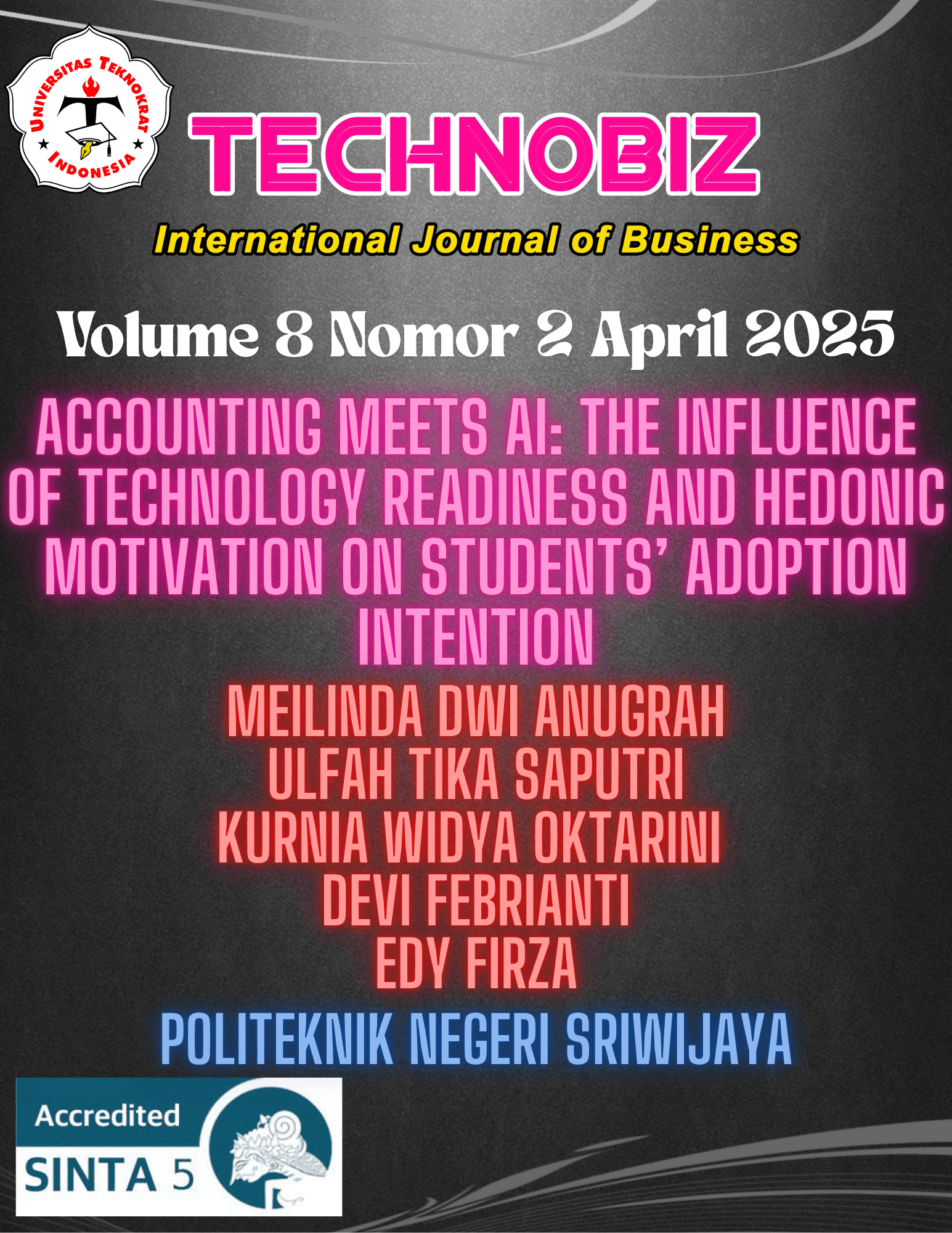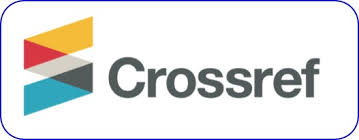ACCOUNTING MEETS AI: THE INFLUENCE OF TECHNOLOGY READINESS AND HEDONIC MOTIVATION ON STUDENTS’ ADOPTION INTENTION
Abstract
This study aims to examine the mediating effect of hedonic motivation on the relationship between technology readiness and the intention to adopt AI technology in the learning process of accounting students at vocational higher education institutions. A purposive sampling technique was employed, resulting in 500 respondents who met the predefined criteria and were included as the study sample. Data were analyzed using Partial Least Squares Structural Equation Modeling (PLS-SEM). The results indicate that technology readiness does not have a direct effect on the intention to adopt AI in the learning process. Instead, hedonic motivation serves as a mediating variable, linking technology readiness to the intention to adopt AI-based technology among accounting students in vocational higher education.
References
Blut M, Wang C. Technology readiness: a meta-analysis of conceptualizations of the construct and its impact on technology usage. J Acad Mark Sci. 2020;48(4):649–69.
Khan S, Khan SU. Tourist motivation to adopt smart hospitality: the impact of smartness and technology readiness. J Hosp Tour Insights. 2024;
Ayasrah FTM. Exploring E-Learning Readiness as Mediating between Trust, Hedonic Motivation, Students’ Expectation, and Intention to Use Technology in Taibah University. J Educ Soc Policy. 2020;7(1).
Cruz-Cárdenas J, Guadalupe-Lanas J, Ramos-Galarza C, Palacio-Fierro A. Drivers of technology readiness and motivations for consumption in explaining the tendency of consumers to use technology-based services. J Bus Res [Internet]. 2021;122(September 2020):217–25. Available from: https://doi.org/10.1016/j.jbusres.2020.08.054
Shonhe L. Conceptual framework to explore artificial intelligence technology (AIT) readiness and adoption intention in records and information management (RIM) practices: a proposal. Rec Manag J. 2024;35(1):18–34.
Khoza TK, Mabitsela T, Nel P. Technology readiness, technology acceptance, and work engagement: A mediational analysis. SA J Ind Psychol. 2024;50(March):0–10.
Sharma M, Kaur R. Accounting conservatism and corporate governance: evidence from India. J Glob Responsib. 2021;12(4):435–51.
Palos-Sanchez PR, Saura JR, Velicia-Martin F. A Case Study on a Hedonic-Motivation System Adoption Model in a Game-Based Student Response System. Int J Hum Comput Interact [Internet]. 2024;40(3):701–18. Available from: https://doi.org/10.1080/10447318.2022.2121801
Deng X, Yu Z. An extended hedonic motivation adoption model of TikTok in higher education. Educ Inf Technol [Internet]. 2023;28(10):13595–617. Available from: https://doi.org/10.1007/s10639-023-11749-x
Lin;, Chien-Hsin, Hsin-Yu Shih PJS. Integrating technology readiness into technology acceptance. Psychol Mark. 2007;Vol. 24(7).
Chiu W, Cho H. The role of technology readiness in individuals’ intention to use health and fitness applications: a comparison between users and non-users. Asia Pacific J Mark Logist. 2021;33(3):807–25.
Jin CH. Predicting the Use of Brand Application Based on a TRAM. Int J Hum Comput Interact [Internet]. 2020;36(2):156–71. Available from: https://doi.org/10.1080/10447318.2019.1609227
Kang S, Choi Y, Kim B. Impact of generative AI service adoption intent on user attitudes: Focusing on the Unified Theory of Acceptance and Use of Technology. Int J Innov Res Sci Stud. 2025;8(1):2021–33.
Zhou Y, Wu X, Qu K. The Role of ChatGPT in English Language Learning: A Hedonic Motivation Perspective on Student Adoption in Chinese Universities. Lang Teach Res Q. 2024;43:132–54.
Uren V, Edwards JS. Technology readiness and the organizational journey towards AI adoption: An empirical study. Int J Inf Manage [Internet]. 2023;68(September 2022):102588. Available from: https://doi.org/10.1016/j.ijinfomgt.2022.102588
Venkatesh V, Thong J y. ., Xu X. Consumer Acceptance and Use of Information Technology: Extending the Unified Theory of Acceptance and Use of Technology by Viswanath Venkatesh, James Y.L. Thong, Xin Xu :: SSRN. MIS Q [Internet]. 2012;36(1):157–78. Available from: https://papers.ssrn.com/sol3/papers.cfm?abstract_id=2002388
Davis FD. Perceived usefulness, perceived ease of use, and user acceptance of information technology. MIS Q Manag Inf Syst. 1989;13(3):319–39.
Joseph F. Hair J. GTMHCMRMS. A primer on partial least squares structural equation modeling (PLS-SEM)-Third Edition. 2021. 385

Copyright (c) 2025 Ulfah Tika Saputri, Meilinda Dwi Anugrah, Kurnia Widya Oktarini, Devi Febrianti, Edy Firza

This work is licensed under a Creative Commons Attribution-ShareAlike 4.0 International License.







